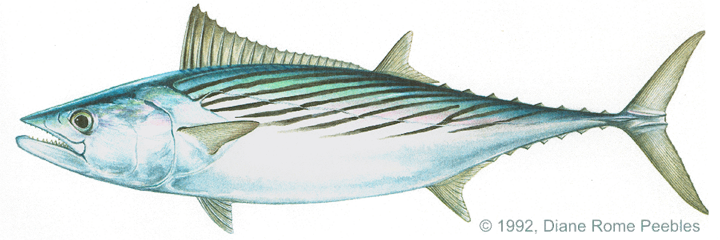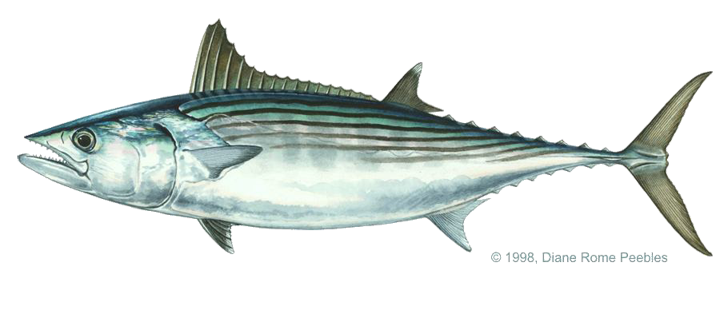Game Fish Identification Reference Guides
Bonito, Atlantic
(Sarda sarda)
(Sarda sarda)

(Bloch, 1793); SCOMBRIDAE FAMILY; also called common bonito, katonkel, belted bonito
Occurs in tropical and temperate waters of the Atlantic Ocean from Argentina to Nova Scotia and from South Africa to Norway. It is apparently rare in the Caribbean Sea and Gulf of Mexico, and is common in the Mediterranean and Black Seas. It is replaced in the Pacific by other Sarda species. The Atlantic bonito is often confused with the skipjack or with other Atlantic Scombroid species. The bonitos have stripes on the back, not the belly. The first dorsal fin has 20 23 spines. The second dorsal fin consists of 13 18 rays followed by 7 10 finlets. The anal fin consists of 14 17 rays followed by 6 8 finlets. The caudal peduncle has a lateral keel on either side. As with all Scombroid fishes, there are also two smaller keels farther back, above and below the main keel. The Sarda species have no teeth on the tongue and no swim bladder. Also, the intestine is straight, rather than folded in the middle. There is a total of 16 23 gill rakers on the first gill arch. The back is steel blue or blue green. The lower flanks and belly are silvery.
This species is pelagic, schooling and migratory and feeds on smaller fishes and squids usually at or near the surface 15 20 miles offshore. A strong, fast swimmer, it is known to skip or leap on the surface when in pursuit of prey. Best fishing methods include trolling at or near the surface, casting, jigging, or live bait fishing. Baits include small pelagic schooling fishes and squid as well as cut fish, strip baits, or any of a variety of artificial lures. The flesh is light colored and of good quality, though held in low esteem by some.
Occurs in tropical and temperate waters of the Atlantic Ocean from Argentina to Nova Scotia and from South Africa to Norway. It is apparently rare in the Caribbean Sea and Gulf of Mexico, and is common in the Mediterranean and Black Seas. It is replaced in the Pacific by other Sarda species. The Atlantic bonito is often confused with the skipjack or with other Atlantic Scombroid species. The bonitos have stripes on the back, not the belly. The first dorsal fin has 20 23 spines. The second dorsal fin consists of 13 18 rays followed by 7 10 finlets. The anal fin consists of 14 17 rays followed by 6 8 finlets. The caudal peduncle has a lateral keel on either side. As with all Scombroid fishes, there are also two smaller keels farther back, above and below the main keel. The Sarda species have no teeth on the tongue and no swim bladder. Also, the intestine is straight, rather than folded in the middle. There is a total of 16 23 gill rakers on the first gill arch. The back is steel blue or blue green. The lower flanks and belly are silvery.
This species is pelagic, schooling and migratory and feeds on smaller fishes and squids usually at or near the surface 15 20 miles offshore. A strong, fast swimmer, it is known to skip or leap on the surface when in pursuit of prey. Best fishing methods include trolling at or near the surface, casting, jigging, or live bait fishing. Baits include small pelagic schooling fishes and squid as well as cut fish, strip baits, or any of a variety of artificial lures. The flesh is light colored and of good quality, though held in low esteem by some.













